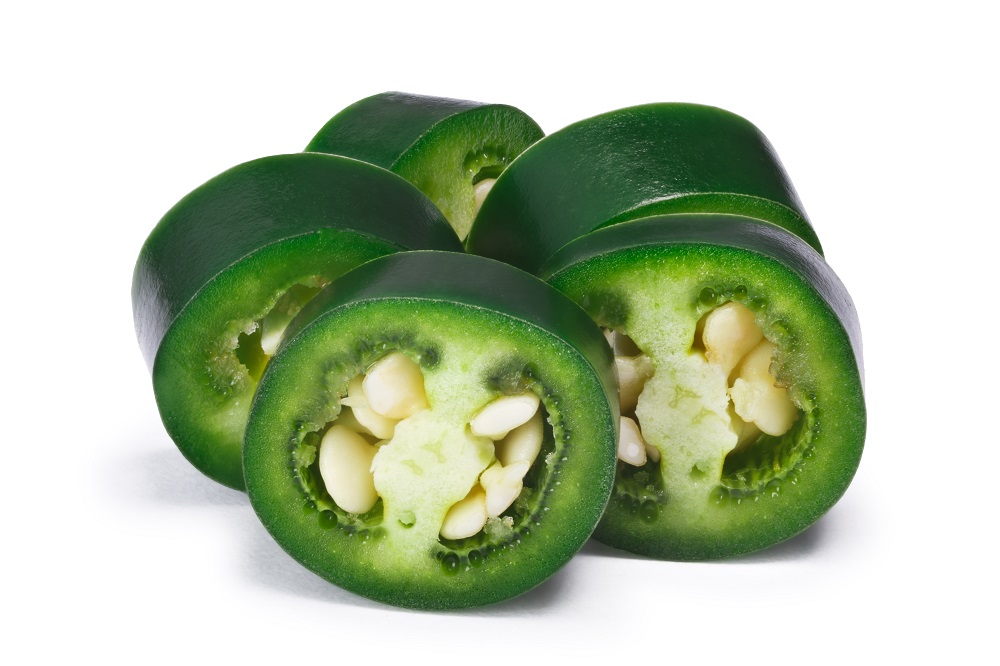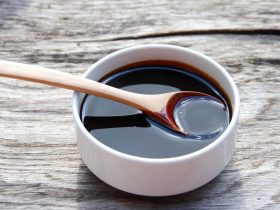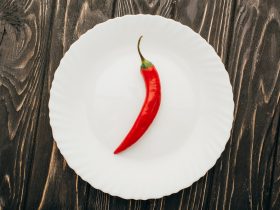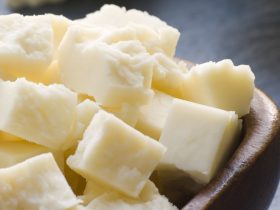Originating from Mexico and primarily used in Mexican cuisine, the serrano pepper is a spicy chili pepper with an approximate scoville scale rating of 10,000 to 23,000, making individual batches of serrano peppers highly variable in their relative spiciness.
Occasionally compared to other types of peppers such as the jalapeno pepper, the serrano pepper is usually consumed in its uncooked form wherein its full flavor and pungency may be experienced, presenting sharp notes of sweetness accented by its distinct spiciness.
However, the serrano pepper may be unavailable in one’s geographical area or its relative spiciness may not be to the consumer’s tastes, necessitating substitution with a suitably similar plant or spice.
The most common heat substitutes for serrano peppers are Jalapeno peppers, tabasco peppers, and Hungarian peppers. Weaker heat substitutes are Poblano peppers, Guero Chile peppers, and banana pepper. Stronger heat substitutes are cayenne pepper, Habanero pepper, and New Mexico chile.
How is the Serrano Pepper Used in Cooking?
The serrano pepper, primarily being used in Mexican cuisine and similar cultures, is used in the creation of certain sauces and condiments in order to add a distinct heat to them, as well as in salads such as pico de gallo, where its fleshy and somewhat moist texture is much to the recipe’s benefit.

Outside of being directly used as a raw ingredient, the serrano pepper may also be sun dried or smoked in order to intensify its heat somewhat, as well as to impart certain flavor notes to its total taste profile, allowing it to add a unique touch to salsas and other foodstuffs.
Why Should the Serrano Pepper be Substituted?
Certain situations or circumstances may require that the serrano pepper be substituted in a recipe, with reasons such as a lack of availability, personal preference, poor quality produce or intentional alterations to the recipe all being a significant contributor to the necessity of finding a suitable substitute.
Whether the cook desires to find a substitute with a similar level of spiciness, one that is weaker or even one that is distinctly stronger than the serrano pepper, a variety of other vegetables and spices are available, most of which are likely available practically anywhere in the world.
Even in cases where the recipe calls for a substitute of serrano pepper with its approximate texture, it is likely that one or two substitutes of this nature can be found without much trouble.
Similar Heat Substitutes for Serrano Pepper
In instances wherein serrano pepper is unavailable to the chef or otherwise not usable, there are certain other peppers that may recreate the same level of pungency and spiciness as the serrano pepper, making the difference nearly unnoticeable for the majority of palettes.
This is especially useful in instances where serrano pepper is not available in the chef’s area, as such peppers like the habanero pepper and jalapeno pepper can usually be purchased practically anywhere in the world, owing to their ease of transport and hardy development.
Jalapeno Pepper
One of the most popular peppers in practically any country, the jalapeno is considered an excellent alternative to the serrano pepper in a multitude of ways that make it suitable as a substitute in any recipe or dish.

The jalapeno possesses a near identical similarity to the serrano pepper in texture, appearance, size and occasionally spiciness, depending on the particular circumstances of its harvesting and growth.
Jalapeno peppers are best used as serrano pepper substitutes in recipes wherein their textural similarity can contribute the most to the recipe, such as in pico de gallo or various baked goods involving the pepper.
Tabasco Pepper
Extremely similar to the serrano pepper in terms of heat, especially that of its weaker varieties, the tabasco pepper is best known for its incorporation into a sauce that is commonly seen in practically any grocery store throughout the world.
The tabasco pepper is significantly smaller than that of the serrano pepper, with a somewhat dry texture and a minute volume of “juice” contained within the fruit itself.
This makes the tabasco pepper a less suitable candidate if textural similarity is an important factor, with recipes like salsa or stews and soups benefitting better from the tabasco pepper as it supplants the pungency and spiciness of the serrano pepper it is substituting for.
Hungarian Pepper
Otherwise referred to as the Hungarian wax pepper, the Hungarian pepper is an excellent substitute for the serrano pepper in cases wherein its textural and pungency similarities can replicate that of the serrano pepper.

One of the primary caveats to using the Hungarian wax pepper as a serrano pepper substitute is its highly variable scoville scale range, placing it anywhere from one-tenth the strength of a serrano pepper to somewhat stronger than the average serrano pepper cultivation.
As such, it may be best to first test the spiciness of any Hungarian wax pepper batch being used to recreate the serrano pepper in a recipe, especially if a particular level of heat is required.
Weaker Heat Substitutes for Serrano Pepper
Though the serrano pepper is considered the essential “medium-hot” pepper wherein it is in the approximate center of the scoville scale as far as pungency is concerned, certain individuals or recipes may necessitate the use of a somewhat less spicy pepper, whether to prevent it from overpowering the flavor profile of the dish or simply due to personal preference.
Fortunately, being in the middle of the scoville scale, the serrano pepper has several close cousins that are weaker in spiciness, making this form of substitution relatively easy to perform.
Poblano Pepper
Similar in appearance and texture to the serrano pepper, the poblano is most often stuffed with various ingredients and roasted so as to bring out its somewhat sweet flavor, making the poblano pepper an excellent substitute to the serrano pepper in recipes wherein it is subjected to direct heat.

The poblano pepper is considered, at its hottest, one-tenth the actual spiciness of the weakest serrano pepper strain, allowing it to be used in practically any recipe without its relative pungency overcoming any other flavors in the dish.
Guero Chile Peppers
Also known as the Santa Fe grande pepper or the yellow hot chili pepper, the guero chile pepper is considerably weaker than most forms of peppers due to its low scoville rating of zero to one-thousand, making it even less pungent than the poblano pepper itself.
The primary use of guero chile peppers as a serrano pepper substitution is in the similarity in flavor, both of which share a mild sweetness that is more often overpowered by the spiciness of serrano peppers, making in more noticeable in guero chile peppers.
The guero chile pepper is unsuitable in instances where the appearance of serrano peppers is also a factor that must be replicated, as the guero chile pepper is oftentimes found to be a yellow to red color with a slightly dry skin and flesh.
Banana Pepper
Perhaps the weakest pepper on this list in terms of relative spiciness, the banana pepper or yellow wax pepper is a slightly tangy pepper with practically no distinctly noticeable heat, oftentimes rating at a five hundred or lower on the scoville scale.
The primary use of banana pepper as a serrano pepper substitute is if a pepper is required in the recipe with no sort of spiciness, making banana pepper the ideal candidate owing to its similarity in appearance and texture to serrano pepper with none of the pungency normally found.
Stronger Heat Substitutes for Serrano Pepper
Some recipes with significant volumes or dairy products or other ingredients that can overpower or smother the spiciness of a serrano pepper may require said serrano pepper be substituted with a correspondingly more pungent pepper so as to maintain some level of spiciness in the dish.
Being considered an “average” pepper in terms of spiciness, the serrano pepper may be substituted by certain other peppers that are considerably stronger and possess a similar taste to serrano peppers.
Cayenne Pepper
Incrementally stronger than the serrano pepper in terms of spiciness, the cayenne pepper is most often dried and ground up so as to make the commonly utilized cayenne pepper spice, though it may also be found in its fresh form as a fruit.

The cayenne pepper is approximately twice as strong in pungency as most forms of the serrano pepper, with a somewhat more dry texture and distinctly red appearance that sets it apart from the serrano pepper in terms of appearance.
The cayenne pepper is best used as a serrano pepper substitute in dishes that do not require the appearance or texture of the serrano pepper be replicated, such as in salsas or other sauces.
Habanero Pepper
Significantly more spicy than the serrano pepper by a large margin, the habanero pepper is best used sparingly when choosing to substitute the serrano pepper owing to the large disparity in levels of pungency.

This, in certain situations, may make the habanero pepper an unsuitable replacement to the serrano pepper if the recipe calls for the habanero to remain non-simmered or unprocessed in some way, as this may create an uneven level of spiciness throughout the dish, such as in salads or sandwiches.
New Mexico Chile
Highly variable in levels of pungency, the new Mexico chile is a group of chile peppers cultivated by specialists so as to be incorporated into various cuisines throughout the South western United States and Mexico.
The variable nature of the new Mexico chile and its subsequent spiciness means that it is often best to choose a specific species of new Mexico chile with your desired level of pungency, allowing the recipe’s spiciness requirement to be met no matter the level required.
References
1. Bosland, Paul W. (2012). “NuMex Heritage 6-4′ New Mexican Chile Pepper” (PDF). Chile Pepper Institute. Las Cruces, NM: Department of Plant and Environmental Sciences, New Mexico State University.
2. Dave DeWitt and Paul W. Bosland (2009). The Complete Chile Pepper Book: A Gardener’s Guide to Choosing, Growing, Preserving, and Cooking. Timber Press. ISBN 978-0881929201.
3. Bosland, P.W. (1996). J. Janick (ed.). “Capsicums: Innovative Uses of an Ancient Crop”. Progress in New Crops. Arlington, Virginia: ASHS Press: 479–487





Hi, I'm Dom
Dom Eats was started to help other people fall in love with food. While cooking can feel intimidating, it doesn't have to be.